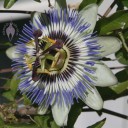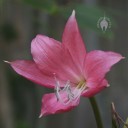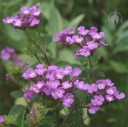Autumnal Equinox
From the equator to the poles, today the entire planet has 12 hours of light and 12 hours of darkness. As the seasons cycle on, our garden is still in full swing. We’re enjoying these sunflowers, passionflowers, and amaryllis. The amaryllis originally came from Dave’s garden in New Orleans, where it bloomed during the summer heat in July. With lots of warm days typical of California in September, it’s now blooming on a West Coast schedule.
Masses of blooms multiply the beauty in these groups of flowers. Clusters of Lantana, Iochroma, and Hesperanthes attract butterflies and hummingbirds into our urban garden.
In the first shot below, Mediterranean hibiscus is a bumblebee favorite. You can see how they’ve knocked orange pollen onto the white petals. Next, the tiny Sweet Alyssum flowers give off a sweet scent, and lots of little seeds guarantee that this annual returns each year. Finally, the Epipactis seedpod I mentioned at the beginning of the summer split open on a hot day. With thousands of microscopic seeds blown by the wind, a few may land in good spots and start to grow. Since this orchid is a San Francisco native, it’ll be right at home.
Explore posts in the same categories: General Gardening, Photos
Subscribe to the About Orchids Blog:
![]()









September 27th, 2009 at 11:07 am
It’s been several years since the summer blooming amaryllis gave us flowers – I think that it bloomed this year because we trimmed back some surrounding plants and gave it more sun light. That flower is still a favorite of mine, but it definitely wants a warm or even hot summer to bloom.
September 30th, 2009 at 7:40 am
Thanks for the beautiful photos.
October 16th, 2009 at 1:27 pm
I trust when you say its a real flower, but that passionflower doesn’t even look real. It’s amazing what mother nature can make. Thanks for the cool pics.
October 21st, 2009 at 7:51 pm
Wow, your garden is amazing, and now I’m superjealous!
October 28th, 2009 at 8:44 am
Great sunflower photo. Maybe some of those Epipatus seeds will blow over to the North Bay and grow in my garden! You said its native to SF. Is it also native to Vallejo?
October 30th, 2009 at 12:09 pm
This species of Epipactis is also native to Vallejo. In fact, it’s the most common native orchid in California. Its range extends to Texas, northern Mexico, and southern Canada. However, it may be rare or gone from developed areas in the North Bay.